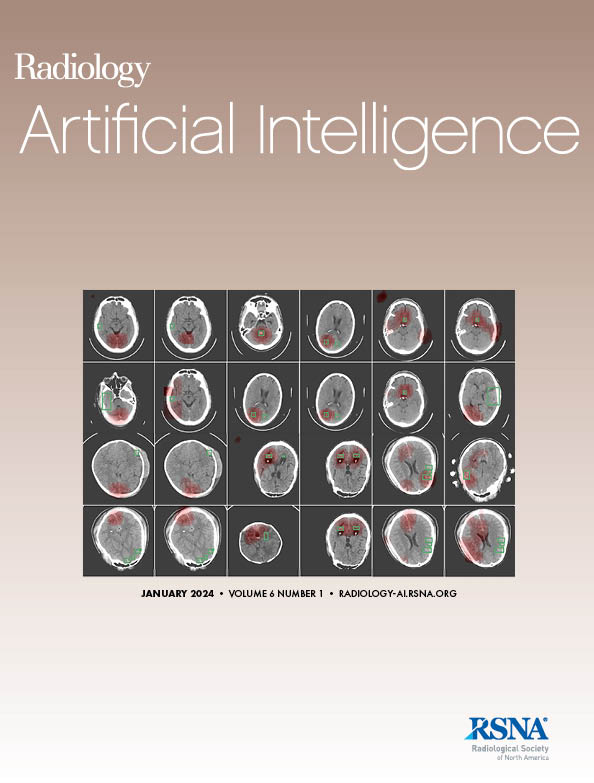Jia Kou, Jun-Yi Peng, Wen-Bing Lv, Chen-Fei Wu, Zi-Hang Chen, Guan-Qun Zhou, Ya-Qin Wang, Li Lin, Li-Jun Lu, Ying Sun
求助PDF
{"title":"A Serial MRI-based Deep Learning Model to Predict Survival in Patients with Locoregionally Advanced Nasopharyngeal Carcinoma.","authors":"Jia Kou, Jun-Yi Peng, Wen-Bing Lv, Chen-Fei Wu, Zi-Hang Chen, Guan-Qun Zhou, Ya-Qin Wang, Li Lin, Li-Jun Lu, Ying Sun","doi":"10.1148/ryai.230544","DOIUrl":null,"url":null,"abstract":"<p><p>Purpose To develop and evaluate a deep learning-based prognostic model for predicting survival in locoregionally advanced nasopharyngeal carcinoma (LA-NPC) using serial MRI before and after induction chemotherapy (IC). Materials and Methods This multicenter retrospective study included 1039 patients with LA-NPC (779 male and 260 female patients; mean age, 44 years ± 11 [SD]) diagnosed between December 2011 and January 2016. A radiomics-clinical prognostic model (model RC) was developed using pre- and post-IC MRI acquisitions and other clinical factors using graph convolutional neural networks. The concordance index (C-index) was used to evaluate model performance in predicting disease-free survival (DFS). The survival benefits of concurrent chemoradiation therapy (CCRT) were analyzed in model-defined risk groups. Results The C-indexes of model RC for predicting DFS were significantly higher than those of TNM staging in the internal (0.79 vs 0.53) and external (0.79 vs 0.62, both <i>P</i> < .001) testing cohorts. The 5-year DFS for the model RC-defined low-risk group was significantly better than that of the high-risk group (90.6% vs 58.9%, <i>P</i> < .001). In high-risk patients, those who underwent CCRT had a higher 5-year DFS rate than those who did not (58.7% vs 28.6%, <i>P</i> = .03). There was no evidence of a difference in 5-year DFS rate in low-risk patients who did or did not undergo CCRT (91.9% vs 81.3%, <i>P</i> = .19). Conclusion Serial MRI before and after IC can effectively help predict survival in LA-NPC. The radiomics-clinical prognostic model developed using a graph convolutional network-based deep learning method showed good risk discrimination capabilities and may facilitate risk-adapted therapy. <b>Keywords:</b> Nasopharyngeal Carcinoma, Deep Learning, Induction Chemotherapy, Serial MRI, MR Imaging, Radiomics, Prognosis, Radiation Therapy/Oncology, Head/Neck <i>Supplemental material is available for this article.</i> © RSNA, 2025.</p>","PeriodicalId":29787,"journal":{"name":"Radiology-Artificial Intelligence","volume":" ","pages":"e230544"},"PeriodicalIF":13.2000,"publicationDate":"2025-02-01","publicationTypes":"Journal Article","fieldsOfStudy":null,"isOpenAccess":false,"openAccessPdf":"","citationCount":"0","resultStr":null,"platform":"Semanticscholar","paperid":null,"PeriodicalName":"Radiology-Artificial Intelligence","FirstCategoryId":"1085","ListUrlMain":"https://doi.org/10.1148/ryai.230544","RegionNum":0,"RegionCategory":null,"ArticlePicture":[],"TitleCN":null,"AbstractTextCN":null,"PMCID":null,"EPubDate":"","PubModel":"","JCR":"Q1","JCRName":"COMPUTER SCIENCE, ARTIFICIAL INTELLIGENCE","Score":null,"Total":0}
引用次数: 0
引用
批量引用
Abstract
Purpose To develop and evaluate a deep learning-based prognostic model for predicting survival in locoregionally advanced nasopharyngeal carcinoma (LA-NPC) using serial MRI before and after induction chemotherapy (IC). Materials and Methods This multicenter retrospective study included 1039 patients with LA-NPC (779 male and 260 female patients; mean age, 44 years ± 11 [SD]) diagnosed between December 2011 and January 2016. A radiomics-clinical prognostic model (model RC) was developed using pre- and post-IC MRI acquisitions and other clinical factors using graph convolutional neural networks. The concordance index (C-index) was used to evaluate model performance in predicting disease-free survival (DFS). The survival benefits of concurrent chemoradiation therapy (CCRT) were analyzed in model-defined risk groups. Results The C-indexes of model RC for predicting DFS were significantly higher than those of TNM staging in the internal (0.79 vs 0.53) and external (0.79 vs 0.62, both P < .001) testing cohorts. The 5-year DFS for the model RC-defined low-risk group was significantly better than that of the high-risk group (90.6% vs 58.9%, P < .001). In high-risk patients, those who underwent CCRT had a higher 5-year DFS rate than those who did not (58.7% vs 28.6%, P = .03). There was no evidence of a difference in 5-year DFS rate in low-risk patients who did or did not undergo CCRT (91.9% vs 81.3%, P = .19). Conclusion Serial MRI before and after IC can effectively help predict survival in LA-NPC. The radiomics-clinical prognostic model developed using a graph convolutional network-based deep learning method showed good risk discrimination capabilities and may facilitate risk-adapted therapy. Keywords: Nasopharyngeal Carcinoma, Deep Learning, Induction Chemotherapy, Serial MRI, MR Imaging, Radiomics, Prognosis, Radiation Therapy/Oncology, Head/Neck Supplemental material is available for this article. © RSNA, 2025.
基于序列mri的深度学习模型预测局部区域晚期鼻咽癌患者的生存。
“刚刚接受”的论文经过了全面的同行评审,并已被接受发表在《放射学:人工智能》杂志上。这篇文章将经过编辑,布局和校样审查,然后在其最终版本出版。请注意,在最终编辑文章的制作过程中,可能会发现可能影响内容的错误。目的建立并评估基于深度学习的预测局部晚期鼻咽癌(LA-NPC)诱导化疗(IC)前后序列MRI生存的预后模型。材料与方法本研究纳入2009年4月至2015年12月诊断的1039例LA-NPC患者,其中男性779例,女性260例,平均年龄44岁[标准差:11]。使用图卷积神经网络(GCN)利用ic前和ic后的MRI和其他临床因素开发了放射组学-临床预后模型(模型RC)。一致性指数(C-index)用于评估模型在预测无病生存(DFS)方面的性能。在模型定义的风险组中分析同步放化疗(CCRT)的生存获益。结果模型RC预测DFS的c指数在内部(0.79比0.53)和外部(0.79比0.62,P均< 0.001)检测队列中显著高于TNM分期。模型rc定义的低危组的5年DFS明显优于高危组(90.6% vs 58.9%, P < 0.001)。在高危患者中,接受CCRT的患者的5年DFS率高于未接受CCRT的患者(58.7%比28.6%,P = 0.03)。没有证据表明接受或未接受CCRT的低风险患者的5年DFS率有差异(91.9% vs 81.3%, P = 0.19)。结论超声造影前后连续MRI可有效预测LA-NPC患者的生存。使用基于gcn的深度学习方法开发的放射组学-临床预后模型显示出良好的风险识别能力,并可能促进风险适应性治疗。©RSNA, 2025年。
本文章由计算机程序翻译,如有差异,请以英文原文为准。

 求助内容:
求助内容: 应助结果提醒方式:
应助结果提醒方式:


